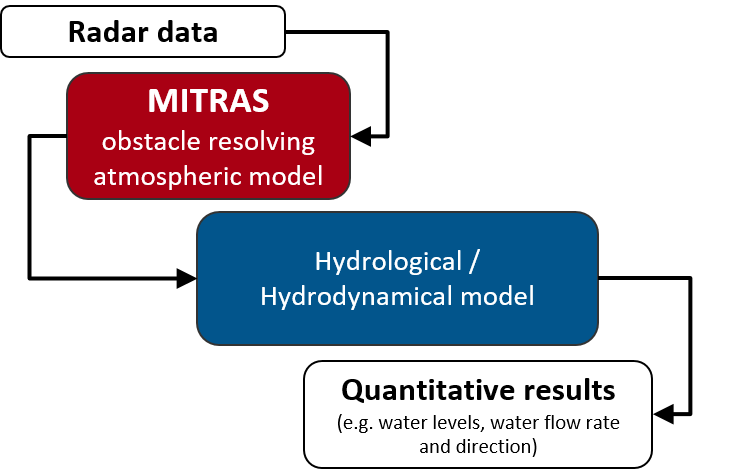Precipitation-Runoff Modelling
Modelling flash floods in urban areas
Contact: Dr. Marita Boettcher (UHH)
Contributors: Friederike Keil (HEREON), Finn Burgemeister (UHH), Christoph Sauer (TUHH)
Within C1, a precipitation-runoff modeling chain is being developed that enables the assessment of water from 4 sides processes. The modeling chain is suitable for developing and quantitatively evaluating sustainable adaptation scenarios for urban areas. To determine the required model complexity, two different quantitative modeling approaches are used: (i) Forcing of the obstacle resolving atmospheric model MITRAS (ORM; Salim et al., 2018) with high-resolution rain radar data (MI UHH, 2022) for heavy precipitation events to create high-resolution precipitation maps. (ii) Rainfall-runoff modeling using a hydrodynamic model forced with the same radar data as for (i) and with the resulting high-resolution precipitation maps of (i) to assess their influence on model results for flash floods.
In addition, C1 uses a chemistry transport model (COSMO-Muscat; Wolke et al. 2004) to investigate the effects of a reduction in air pollution emissions on heavy precipitation in Hamburg.

References:
Meteorological Institute, Universität Hamburg (MI UHH). Wetterradar Hamburg. https://wetterradar.uni-hamburg.de. Accessed 29.03.2022.
Salim M.H, Schlünzen K.H., Grawe D., Boettcher M., Gierisch A.M.U., Fock B.H. (2018): The microscale obstacle-resolving meteorological model MITRAS v2.0: model theory. Geosci. Model Dev., 11, 3427–3445, https://doi.org/10.5194/gmd-11-3427-2018.
Wolke, R., O. Knoth, O. Hellmuth, W. Schröder and E. Renner, 2004, The parallel model system LM-MUSCAT for chemistry-transport simulations: Coupling scheme, parallelization and application, in: G.R. Joubert, W.E. Nagel, F.J. Peters, and W.V. Walter, Eds., Parallel Computing: Software Technology, Algorithms, Architectures, and Applications, Elsevier, Amsterdam, The Netherlands, 363-370.
Related scientific C1 publications
Ferner K., Böttcher M., Schlünzen K. H. (2022): Modelling the heterogeneity of rain in an urban neighbourhood with an obstacle-resolving model. Meteorologische Zeitschrift. 32, 1, S. 67-81 15 S. DOI: 10.1127/metz/2022/1149.
Burgemeister, F., Clemens, M., and Ament, F. (2023). Reanalysis of multi-year high-resolution X-band weather radar observations in Hamburg, Earth Syst. Sci. Data Discuss. [preprint], https://doi.org/10.5194/essd-2023-300, in review.
Burgemeister, F., Finn, T., Schaper, M., and Büchau, Y. (2023). pylawr: A Python Package For Processing Local Area Weather Radars [Code]. Zenodo. https://doi.org/10.5281/zenodo.8182628.
Burgemeister, F., M. Clemens, and F. Ament (2022). Multi-year X-band weather radar observations in Hamburg (LAWR HHG) [Data set]. World Data Center for Climate (WDCC) at DKRZ. https://doi.org/10.26050/wdcc/lawr_uhh_hhg.
